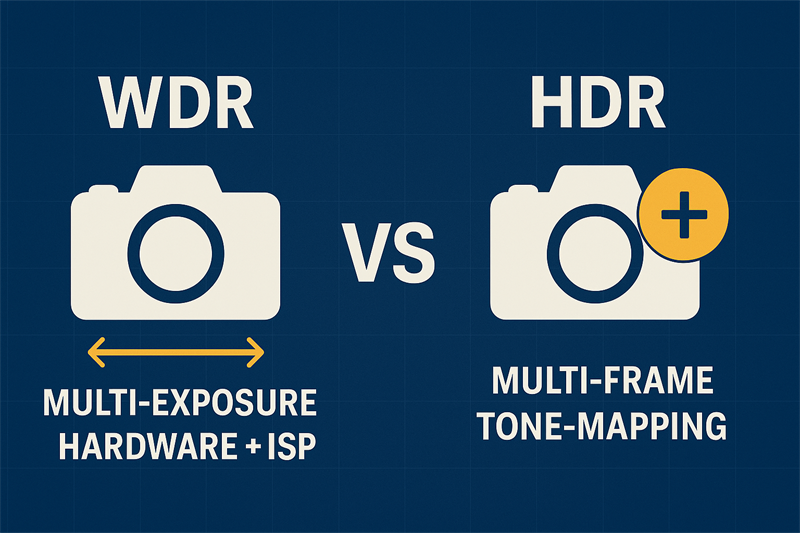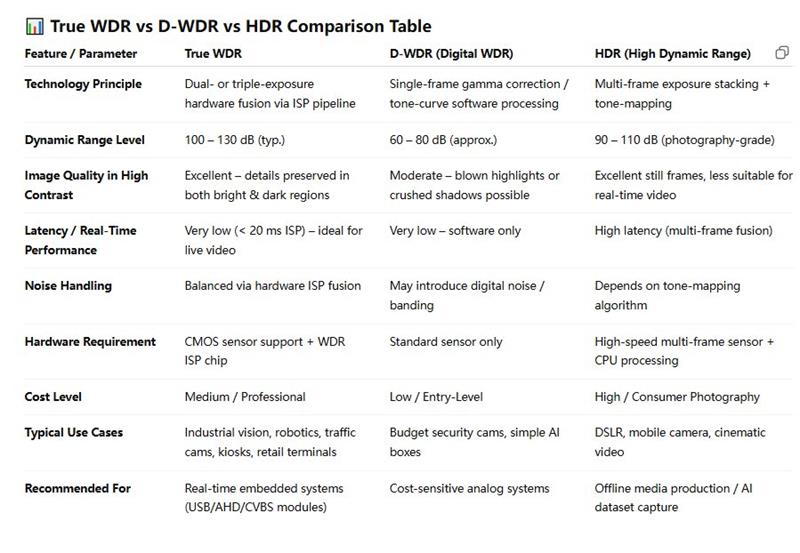
Imagine you are standing inside a room looking out a bright, sunny window. Your eyes can effortlessly see the details of the furniture inside the room and the details of the trees and cars outside the window at the same time.
A standard camera cannot do this. It has to make a choice:
WDR is the technology that allows a camera to "see" more like the human eye, capturing details in both the dark and bright areas of a scene simultaneously.
Dynamic Range in photography refers to the ratio between the brightest and darkest tones a camera can capture in a single image. A scene with very bright highlights (like a sunny sky) and deep shadows (like the inside of a garage) is called a "high-contrast" or "wide dynamic range" scene.
WDR (Wide Dynamic Range) is a feature in modern cameras that uses advanced hardware and software to balance the lighting in these high-contrast scenes, producing a single image where details in both the shadows and highlights are clearly visible.

The most effective type, known as True WDR, is a hardware-based solution that works by capturing multiple images of the same scene at different exposure levels and then merging them.
Here’s a simplified breakdown of the process:
This capability is often measured in decibels (dB). A higher dB rating (e.g., 120 dB or 140 dB) indicates a stronger WDR effect and better performance in extreme lighting conditions.
WDR is critical in any application with variable or high-contrast lighting, such as:
In short, WDR is the essential camera technology that transforms a challenging, high-contrast scene from an unusable mess of silhouettes and whiteouts into a clear, detailed, and usable image.
|
Category |
HDR (High Dynamic Range) |
WDR (Wide Dynamic Range) |
|
1️⃣ Definition |
Captures and combines multiple images at different exposures (high, medium, low) to achieve high dynamic range in a single frame. |
Enhances details in both bright and dark regions simultaneously by balancing exposure electronically, often in a single frame. |
|
2️⃣ Application |
Common in photography, video recording, consumer electronics, and premium surveillance; used where color and detail preservation is critical. |
Designed for real-time video, industrial cameras, CCTV, automotive, robotics, and embedded systems requiring continuous frame output. |
|
3️⃣ Processing Method |
Multi-frame capture + tone mapping; combines 3–5 exposures, resulting in higher computational load and slight delay (not real-time). |
Single-frame (or dual-scan) processing using line-by-line exposure or digital gain control within the sensor; real-time capable. |
|
4️⃣ Typical Use Cases |
Professional photography, cinematic video, drones, high-end consumer cameras, smartphone imaging. |
Machine vision, industrial monitoring, traffic cameras, robotics, kiosks, access control systems under strong backlight or low light. |
|
5️⃣ Dynamic Range Coverage |
100–120 dB or more (depending on sensor and algorithm). |
Typically 60–100 dB, depending on sensor (e.g., Sony STARVIS WDR sensors reach ~90 dB). |
|
6️⃣ Intensity of Processing |
Heavy—requires frame buffering, image fusion, and tone mapping; often done in ISP or software post-processing. |
Light—hardware-level dynamic compression; optimized for low-latency and continuous streaming. |
|
7️⃣ Difference with Human Eyes |
HDR exceeds human eye’s single-moment perception but can appear unnatural if tone mapping is aggressive. |
WDR emulates the eye’s adaptation ability across bright/dark areas, yielding a more natural “real-world” view. |
|
8️⃣ Consumer vs. Professional Use |
HDR is prevalent in consumer and creative imaging (DSLRs, smartphones, action cameras). |
WDR dominates professional and industrial vision systems (factory automation, traffic monitoring, robotics, surveillance). |
|
9️⃣ Cost Considerations |
Requires higher processing power and larger data storage; higher ISP and CPU costs. |
Lower cost—implemented directly on-sensor or in the analog/digital front-end; minimal impact on BOM for industrial systems. |

|
Scenario |
Recommended Technology |
Reason |
|
Machine Vision / Industrial Inspection |
WDR |
Real-time performance and reliability under fluctuating lighting. |
|
Consumer Photography / Creative Video |
HDR |
Better tone depth and color rendering. |
|
Robotics & Automation |
WDR |
Continuous exposure control, no delay. |
|
Smart Retail / Kiosks |
WDR |
Natural exposure balance for mixed lighting. |
|
Outdoor Surveillance / Traffic |
WDR |
High dynamic range + no motion ghosting. |
|
Drone & Cinematic Capture |
HDR |
High detail and color reproduction. |
Q1. What is the main difference between True WDR and D-WDR?
True WDR uses multi-exposure CMOS capture + ISP fusion, delivering up to 120 dB range. D-WDR is purely software-based brightness/contrast stretching; it does not increase true sensor dynamic range.
Q2. How is WDR measured in decibels (dB)?
Dynamic range = 20 × log₁₀ (max signal / min signal).
A typical sensor ≈ 60 dB; True WDR modules reach 100 – 130 dB.
Higher dB means better detail retention in extreme lighting conditions.
Q3. What are the hardware requirements for True WDR modules?
A CMOS sensor with dual gain or multi-exposure readout (Sony STARVIS IMX335/IMX385 series) plus an ISP that supports frame fusion and tone-mapping.
The module must also ensure low latency signal processing (< 20 ms).
Q4. When should I choose D-WDR over True WDR?
Use D-WDR only for cost-sensitive, standard lighting projects where you don’t need full shadow/highlight preservation — for example indoor budget AHD or CVBS systems.
Q5. How does HDR differ from WDR in industrial applications?
HDR targets aesthetic color and detail enhancement through multi-frame fusion — it’s excellent for still imagery or cinematic video but adds delay.
WDR is optimized for real-time operation in industrial vision, robotics, and surveillance where instant frame output is critical.